Chapter 4: Building Information Modelling (BIM) and Construction
VerifiedAdded on 2022/08/15
|18
|8885
|45
Report
AI Summary
This report, "Chapter 4 Building Information Modelling (BIM) a Paradigm Shift in Construction," examines the profound impact of BIM on the UK construction industry, particularly after the government's 2016 mandate for BIM Level 2 maturity. It highlights BIM's role in addressing inefficiencies, improving project coordination, and fostering collaboration. The report contrasts CAD and BIM, detailing BIM maturity levels from Level 0 to Level 3, and explores the definitions and benefits of BIM. It also discusses the historical context, from ancient Egypt to modern advancements, and the challenges in BIM adoption. The report emphasizes BIM's significance as a technological and philosophical shift, promoting a data-intensive environment for more effective project delivery.
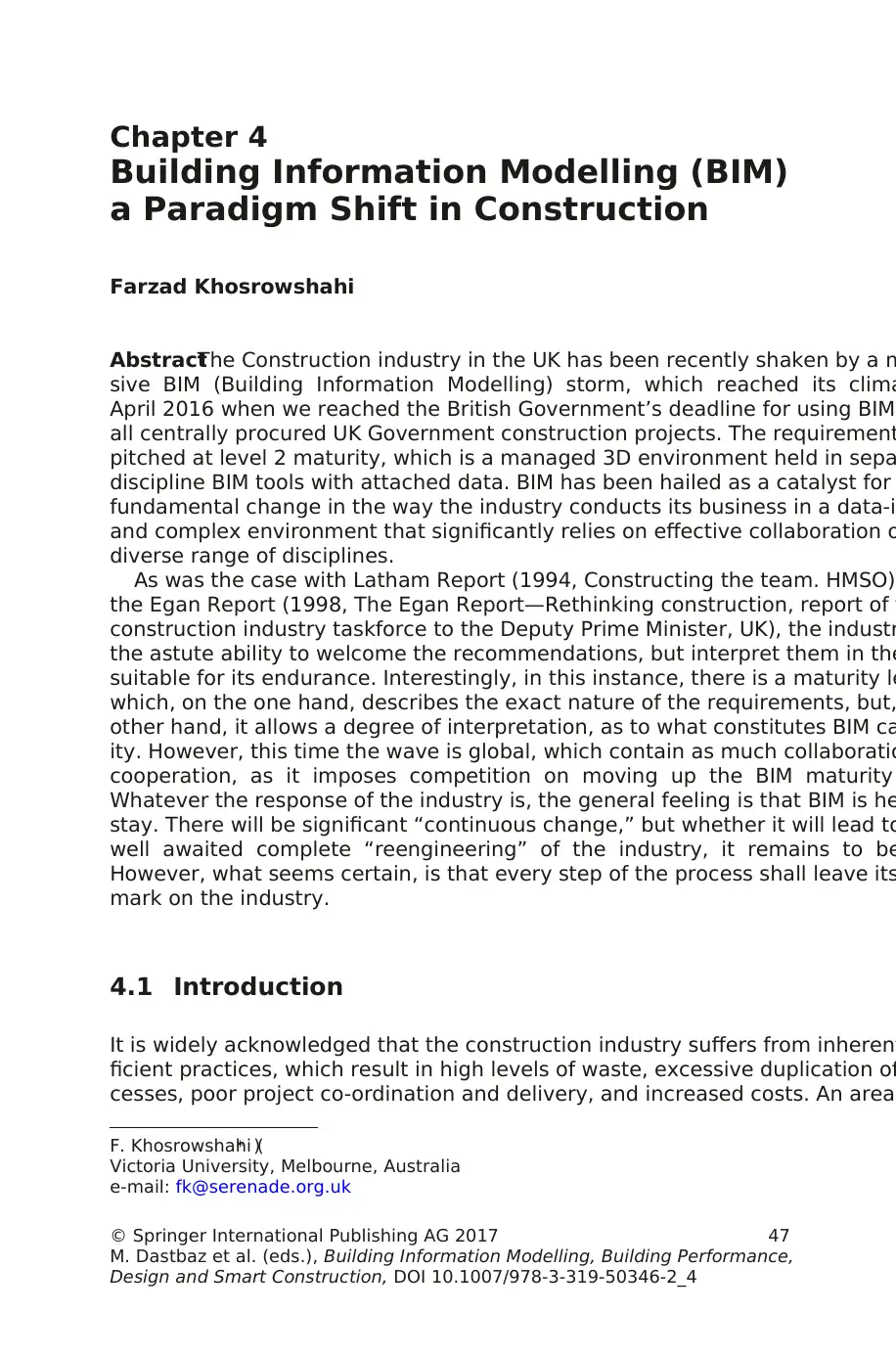
47
Chapter 4
Building Information Modelling (BIM)
a Paradigm Shift in Construction
Farzad Khosrowshahi
AbstractThe Construction industry in the UK has been recently shaken by a m
sive BIM (Building Information Modelling) storm, which reached its clima
April 2016 when we reached the British Government’s deadline for using BIM
all centrally procured UK Government construction projects. The requirement
pitched at level 2 maturity, which is a managed 3D environment held in sepa
discipline BIM tools with attached data. BIM has been hailed as a catalyst for
fundamental change in the way the industry conducts its business in a data-i
and complex environment that significantly relies on effective collaboration o
diverse range of disciplines.
As was the case with Latham Report (1994, Constructing the team. HMSO)
the Egan Report (1998, The Egan Report—Rethinking construction, report of t
construction industry taskforce to the Deputy Prime Minister, UK), the industr
the astute ability to welcome the recommendations, but interpret them in the
suitable for its endurance. Interestingly, in this instance, there is a maturity le
which, on the one hand, describes the exact nature of the requirements, but,
other hand, it allows a degree of interpretation, as to what constitutes BIM ca
ity. However, this time the wave is global, which contain as much collaboratio
cooperation, as it imposes competition on moving up the BIM maturity
Whatever the response of the industry is, the general feeling is that BIM is he
stay. There will be significant “continuous change,” but whether it will lead to
well awaited complete “reengineering” of the industry, it remains to be
However, what seems certain, is that every step of the process shall leave its
mark on the industry.
4.1 Introduction
It is widely acknowledged that the construction industry suffers from inherent
ficient practices, which result in high levels of waste, excessive duplication of
cesses, poor project co-ordination and delivery, and increased costs. An area
F. Khosrowshahi (* )
Victoria University, Melbourne, Australia
e-mail: fk@serenade.org.uk
© Springer International Publishing AG 2017
M. Dastbaz et al. (eds.), Building Information Modelling, Building Performance,
Design and Smart Construction, DOI 10.1007/978-3-319-50346-2_4
Chapter 4
Building Information Modelling (BIM)
a Paradigm Shift in Construction
Farzad Khosrowshahi
AbstractThe Construction industry in the UK has been recently shaken by a m
sive BIM (Building Information Modelling) storm, which reached its clima
April 2016 when we reached the British Government’s deadline for using BIM
all centrally procured UK Government construction projects. The requirement
pitched at level 2 maturity, which is a managed 3D environment held in sepa
discipline BIM tools with attached data. BIM has been hailed as a catalyst for
fundamental change in the way the industry conducts its business in a data-i
and complex environment that significantly relies on effective collaboration o
diverse range of disciplines.
As was the case with Latham Report (1994, Constructing the team. HMSO)
the Egan Report (1998, The Egan Report—Rethinking construction, report of t
construction industry taskforce to the Deputy Prime Minister, UK), the industr
the astute ability to welcome the recommendations, but interpret them in the
suitable for its endurance. Interestingly, in this instance, there is a maturity le
which, on the one hand, describes the exact nature of the requirements, but,
other hand, it allows a degree of interpretation, as to what constitutes BIM ca
ity. However, this time the wave is global, which contain as much collaboratio
cooperation, as it imposes competition on moving up the BIM maturity
Whatever the response of the industry is, the general feeling is that BIM is he
stay. There will be significant “continuous change,” but whether it will lead to
well awaited complete “reengineering” of the industry, it remains to be
However, what seems certain, is that every step of the process shall leave its
mark on the industry.
4.1 Introduction
It is widely acknowledged that the construction industry suffers from inherent
ficient practices, which result in high levels of waste, excessive duplication of
cesses, poor project co-ordination and delivery, and increased costs. An area
F. Khosrowshahi (* )
Victoria University, Melbourne, Australia
e-mail: fk@serenade.org.uk
© Springer International Publishing AG 2017
M. Dastbaz et al. (eds.), Building Information Modelling, Building Performance,
Design and Smart Construction, DOI 10.1007/978-3-319-50346-2_4
Paraphrase This Document
Need a fresh take? Get an instant paraphrase of this document with our AI Paraphraser
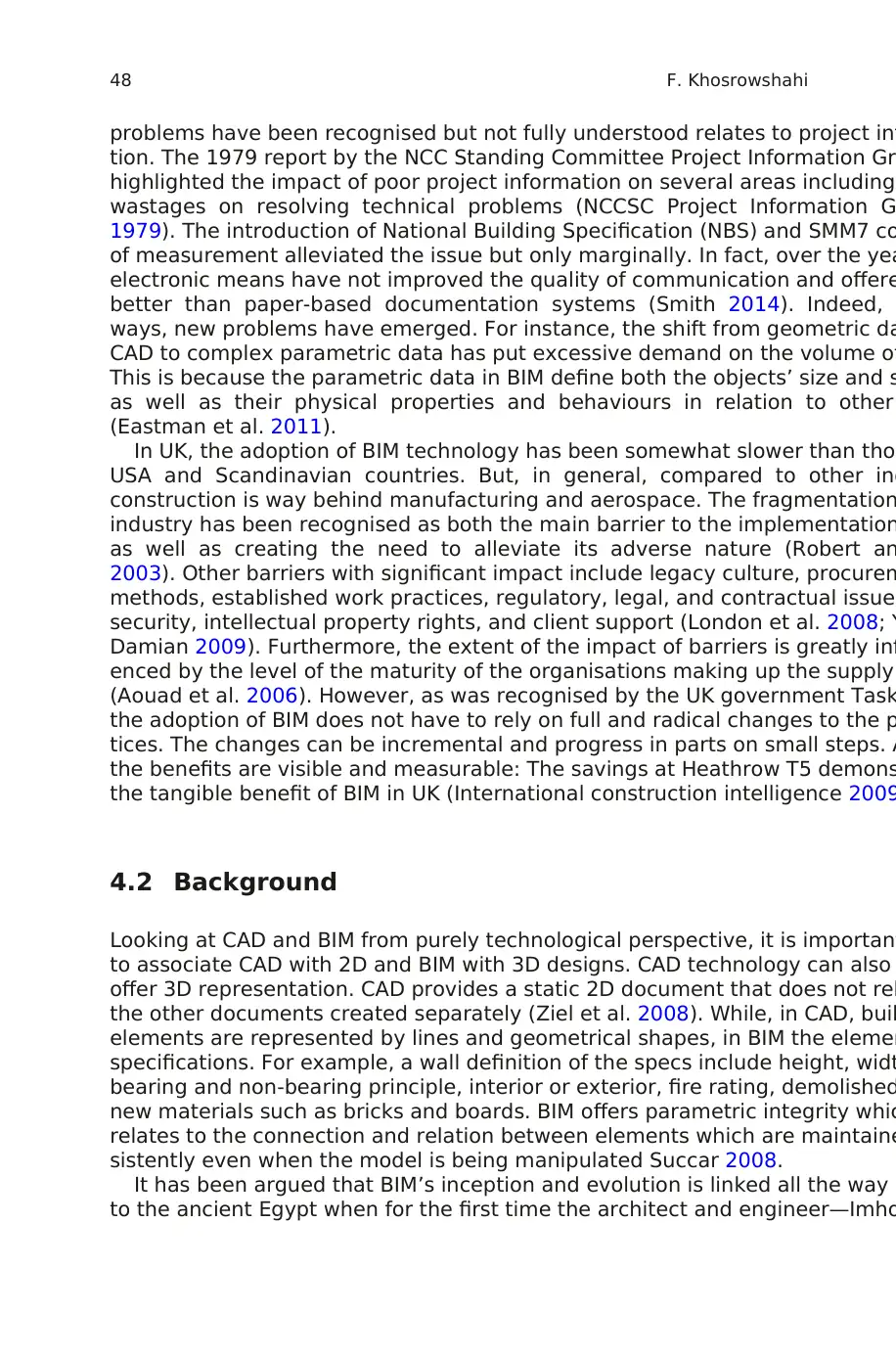
48
problems have been recognised but not fully understood relates to project inf
tion. The 1979 report by the NCC Standing Committee Project Information Gr
highlighted the impact of poor project information on several areas including
wastages on resolving technical problems (NCCSC Project Information G
1979). The introduction of National Building Specification (NBS) and SMM7 co
of measurement alleviated the issue but only marginally. In fact, over the yea
electronic means have not improved the quality of communication and offere
better than paper-based documentation systems (Smith 2014). Indeed,
ways, new problems have emerged. For instance, the shift from geometric da
CAD to complex parametric data has put excessive demand on the volume of
This is because the parametric data in BIM define both the objects’ size and s
as well as their physical properties and behaviours in relation to other
(Eastman et al. 2011).
In UK, the adoption of BIM technology has been somewhat slower than tho
USA and Scandinavian countries. But, in general, compared to other ind
construction is way behind manufacturing and aerospace. The fragmentation
industry has been recognised as both the main barrier to the implementation
as well as creating the need to alleviate its adverse nature (Robert an
2003). Other barriers with significant impact include legacy culture, procurem
methods, established work practices, regulatory, legal, and contractual issues
security, intellectual property rights, and client support (London et al. 2008; Y
Damian 2009). Furthermore, the extent of the impact of barriers is greatly infl
enced by the level of the maturity of the organisations making up the supply
(Aouad et al. 2006). However, as was recognised by the UK government Task
the adoption of BIM does not have to rely on full and radical changes to the p
tices. The changes can be incremental and progress in parts on small steps. A
the benefits are visible and measurable: The savings at Heathrow T5 demons
the tangible benefit of BIM in UK (International construction intelligence 2009
4.2 Background
Looking at CAD and BIM from purely technological perspective, it is importan
to associate CAD with 2D and BIM with 3D designs. CAD technology can also
offer 3D representation. CAD provides a static 2D document that does not rel
the other documents created separately (Ziel et al. 2008). While, in CAD, buil
elements are represented by lines and geometrical shapes, in BIM the elemen
specifications. For example, a wall definition of the specs include height, widt
bearing and non-bearing principle, interior or exterior, fire rating, demolished
new materials such as bricks and boards. BIM offers parametric integrity whic
relates to the connection and relation between elements which are maintaine
sistently even when the model is being manipulated Succar 2008.
It has been argued that BIM’s inception and evolution is linked all the way b
to the ancient Egypt when for the first time the architect and engineer—Imho
F. Khosrowshahi
problems have been recognised but not fully understood relates to project inf
tion. The 1979 report by the NCC Standing Committee Project Information Gr
highlighted the impact of poor project information on several areas including
wastages on resolving technical problems (NCCSC Project Information G
1979). The introduction of National Building Specification (NBS) and SMM7 co
of measurement alleviated the issue but only marginally. In fact, over the yea
electronic means have not improved the quality of communication and offere
better than paper-based documentation systems (Smith 2014). Indeed,
ways, new problems have emerged. For instance, the shift from geometric da
CAD to complex parametric data has put excessive demand on the volume of
This is because the parametric data in BIM define both the objects’ size and s
as well as their physical properties and behaviours in relation to other
(Eastman et al. 2011).
In UK, the adoption of BIM technology has been somewhat slower than tho
USA and Scandinavian countries. But, in general, compared to other ind
construction is way behind manufacturing and aerospace. The fragmentation
industry has been recognised as both the main barrier to the implementation
as well as creating the need to alleviate its adverse nature (Robert an
2003). Other barriers with significant impact include legacy culture, procurem
methods, established work practices, regulatory, legal, and contractual issues
security, intellectual property rights, and client support (London et al. 2008; Y
Damian 2009). Furthermore, the extent of the impact of barriers is greatly infl
enced by the level of the maturity of the organisations making up the supply
(Aouad et al. 2006). However, as was recognised by the UK government Task
the adoption of BIM does not have to rely on full and radical changes to the p
tices. The changes can be incremental and progress in parts on small steps. A
the benefits are visible and measurable: The savings at Heathrow T5 demons
the tangible benefit of BIM in UK (International construction intelligence 2009
4.2 Background
Looking at CAD and BIM from purely technological perspective, it is importan
to associate CAD with 2D and BIM with 3D designs. CAD technology can also
offer 3D representation. CAD provides a static 2D document that does not rel
the other documents created separately (Ziel et al. 2008). While, in CAD, buil
elements are represented by lines and geometrical shapes, in BIM the elemen
specifications. For example, a wall definition of the specs include height, widt
bearing and non-bearing principle, interior or exterior, fire rating, demolished
new materials such as bricks and boards. BIM offers parametric integrity whic
relates to the connection and relation between elements which are maintaine
sistently even when the model is being manipulated Succar 2008.
It has been argued that BIM’s inception and evolution is linked all the way b
to the ancient Egypt when for the first time the architect and engineer—Imho
F. Khosrowshahi
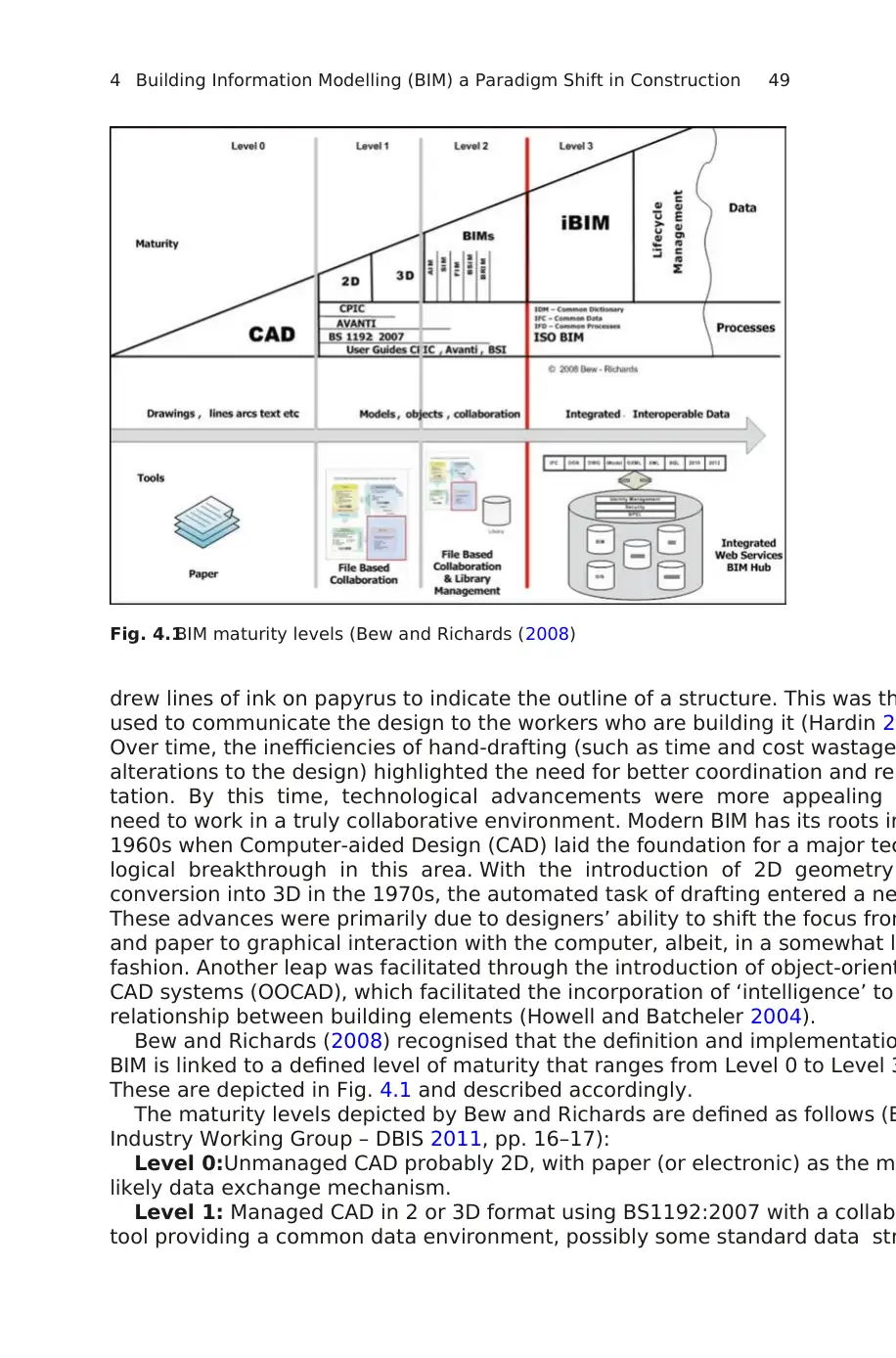
49
drew lines of ink on papyrus to indicate the outline of a structure. This was th
used to communicate the design to the workers who are building it (Hardin 2
Over time, the inefficiencies of hand-drafting (such as time and cost wastage
alterations to the design) highlighted the need for better coordination and rep
tation. By this time, technological advancements were more appealing
need to work in a truly collaborative environment. Modern BIM has its roots in
1960s when Computer-aided Design (CAD) laid the foundation for a major tec
logical breakthrough in this area. With the introduction of 2D geometry
conversion into 3D in the 1970s, the automated task of drafting entered a ne
These advances were primarily due to designers’ ability to shift the focus from
and paper to graphical interaction with the computer, albeit, in a somewhat l
fashion. Another leap was facilitated through the introduction of object-orient
CAD systems (OOCAD), which facilitated the incorporation of ‘intelligence’ to
relationship between building elements (Howell and Batcheler 2004).
Bew and Richards (2008) recognised that the definition and implementatio
BIM is linked to a defined level of maturity that ranges from Level 0 to Level 3
These are depicted in Fig. 4.1 and described accordingly.
The maturity levels depicted by Bew and Richards are defined as follows (B
Industry Working Group – DBIS 2011, pp. 16–17):
Level 0:Unmanaged CAD probably 2D, with paper (or electronic) as the m
likely data exchange mechanism.
Level 1: Managed CAD in 2 or 3D format using BS1192:2007 with a collab
tool providing a common data environment, possibly some standard data str
Fig. 4.1BIM maturity levels (Bew and Richards (2008)
4 Building Information Modelling (BIM) a Paradigm Shift in Construction
drew lines of ink on papyrus to indicate the outline of a structure. This was th
used to communicate the design to the workers who are building it (Hardin 2
Over time, the inefficiencies of hand-drafting (such as time and cost wastage
alterations to the design) highlighted the need for better coordination and rep
tation. By this time, technological advancements were more appealing
need to work in a truly collaborative environment. Modern BIM has its roots in
1960s when Computer-aided Design (CAD) laid the foundation for a major tec
logical breakthrough in this area. With the introduction of 2D geometry
conversion into 3D in the 1970s, the automated task of drafting entered a ne
These advances were primarily due to designers’ ability to shift the focus from
and paper to graphical interaction with the computer, albeit, in a somewhat l
fashion. Another leap was facilitated through the introduction of object-orient
CAD systems (OOCAD), which facilitated the incorporation of ‘intelligence’ to
relationship between building elements (Howell and Batcheler 2004).
Bew and Richards (2008) recognised that the definition and implementatio
BIM is linked to a defined level of maturity that ranges from Level 0 to Level 3
These are depicted in Fig. 4.1 and described accordingly.
The maturity levels depicted by Bew and Richards are defined as follows (B
Industry Working Group – DBIS 2011, pp. 16–17):
Level 0:Unmanaged CAD probably 2D, with paper (or electronic) as the m
likely data exchange mechanism.
Level 1: Managed CAD in 2 or 3D format using BS1192:2007 with a collab
tool providing a common data environment, possibly some standard data str
Fig. 4.1BIM maturity levels (Bew and Richards (2008)
4 Building Information Modelling (BIM) a Paradigm Shift in Construction
⊘ This is a preview!⊘
Do you want full access?
Subscribe today to unlock all pages.

Trusted by 1+ million students worldwide
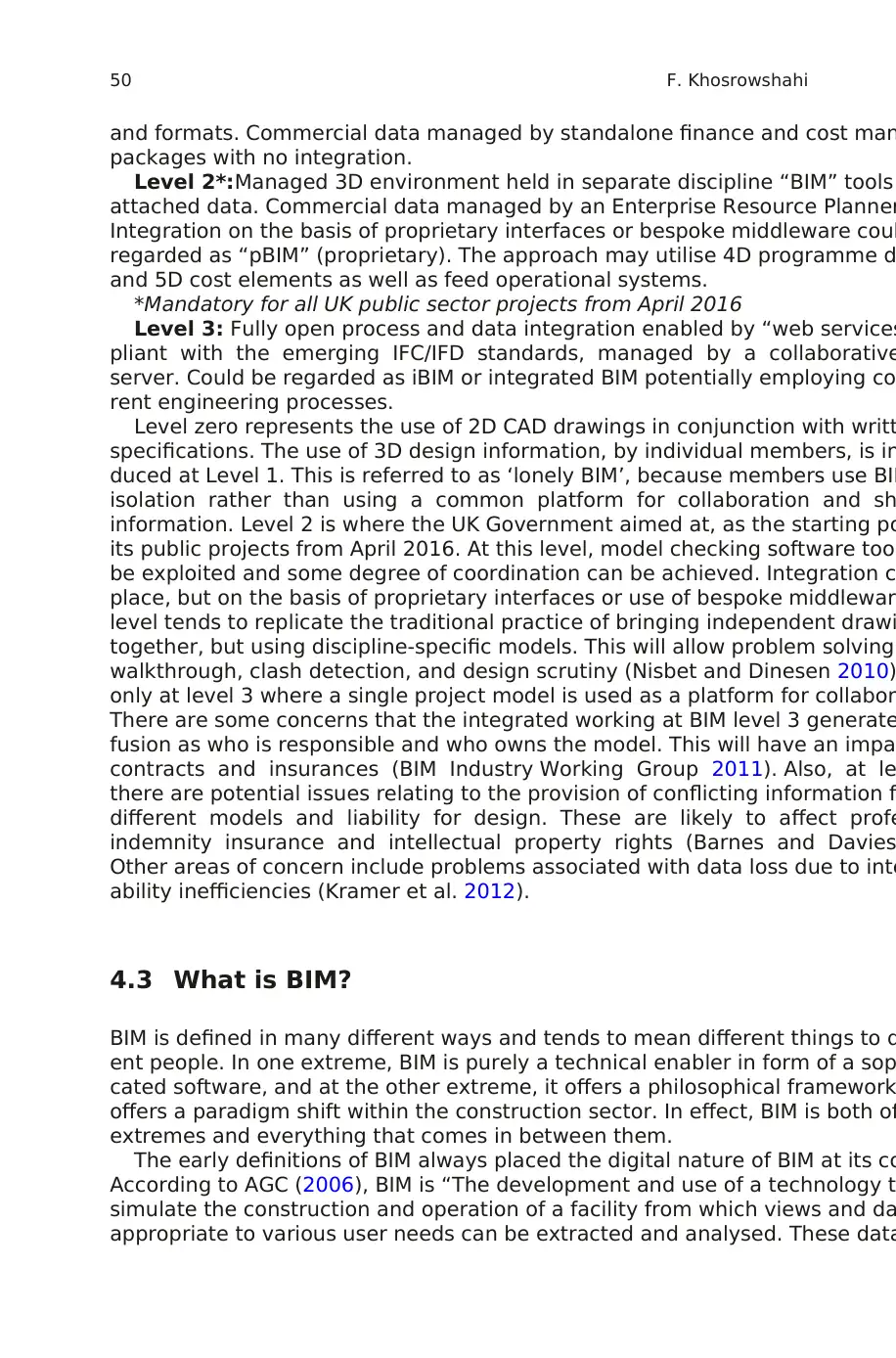
50
and formats. Commercial data managed by standalone finance and cost man
packages with no integration.
Level 2*:Managed 3D environment held in separate discipline “BIM” tools
attached data. Commercial data managed by an Enterprise Resource Planner
Integration on the basis of proprietary interfaces or bespoke middleware coul
regarded as “pBIM” (proprietary). The approach may utilise 4D programme d
and 5D cost elements as well as feed operational systems.
*Mandatory for all UK public sector projects from April 2016
Level 3: Fully open process and data integration enabled by “web services
pliant with the emerging IFC/IFD standards, managed by a collaborative
server. Could be regarded as iBIM or integrated BIM potentially employing co
rent engineering processes.
Level zero represents the use of 2D CAD drawings in conjunction with writt
specifications. The use of 3D design information, by individual members, is in
duced at Level 1. This is referred to as ‘lonely BIM’, because members use BIM
isolation rather than using a common platform for collaboration and sh
information. Level 2 is where the UK Government aimed at, as the starting po
its public projects from April 2016. At this level, model checking software tool
be exploited and some degree of coordination can be achieved. Integration c
place, but on the basis of proprietary interfaces or use of bespoke middlewar
level tends to replicate the traditional practice of bringing independent drawi
together, but using discipline-specific models. This will allow problem solving
walkthrough, clash detection, and design scrutiny (Nisbet and Dinesen 2010)
only at level 3 where a single project model is used as a platform for collabor
There are some concerns that the integrated working at BIM level 3 generate
fusion as who is responsible and who owns the model. This will have an impa
contracts and insurances (BIM Industry Working Group 2011). Also, at le
there are potential issues relating to the provision of conflicting information f
different models and liability for design. These are likely to affect profe
indemnity insurance and intellectual property rights (Barnes and Davies
Other areas of concern include problems associated with data loss due to inte
ability inefficiencies (Kramer et al. 2012).
4.3 What is BIM?
BIM is defined in many different ways and tends to mean different things to d
ent people. In one extreme, BIM is purely a technical enabler in form of a sop
cated software, and at the other extreme, it offers a philosophical framework
offers a paradigm shift within the construction sector. In effect, BIM is both of
extremes and everything that comes in between them.
The early definitions of BIM always placed the digital nature of BIM at its co
According to AGC (2006), BIM is “The development and use of a technology t
simulate the construction and operation of a facility from which views and da
appropriate to various user needs can be extracted and analysed. These data
F. Khosrowshahi
and formats. Commercial data managed by standalone finance and cost man
packages with no integration.
Level 2*:Managed 3D environment held in separate discipline “BIM” tools
attached data. Commercial data managed by an Enterprise Resource Planner
Integration on the basis of proprietary interfaces or bespoke middleware coul
regarded as “pBIM” (proprietary). The approach may utilise 4D programme d
and 5D cost elements as well as feed operational systems.
*Mandatory for all UK public sector projects from April 2016
Level 3: Fully open process and data integration enabled by “web services
pliant with the emerging IFC/IFD standards, managed by a collaborative
server. Could be regarded as iBIM or integrated BIM potentially employing co
rent engineering processes.
Level zero represents the use of 2D CAD drawings in conjunction with writt
specifications. The use of 3D design information, by individual members, is in
duced at Level 1. This is referred to as ‘lonely BIM’, because members use BIM
isolation rather than using a common platform for collaboration and sh
information. Level 2 is where the UK Government aimed at, as the starting po
its public projects from April 2016. At this level, model checking software tool
be exploited and some degree of coordination can be achieved. Integration c
place, but on the basis of proprietary interfaces or use of bespoke middlewar
level tends to replicate the traditional practice of bringing independent drawi
together, but using discipline-specific models. This will allow problem solving
walkthrough, clash detection, and design scrutiny (Nisbet and Dinesen 2010)
only at level 3 where a single project model is used as a platform for collabor
There are some concerns that the integrated working at BIM level 3 generate
fusion as who is responsible and who owns the model. This will have an impa
contracts and insurances (BIM Industry Working Group 2011). Also, at le
there are potential issues relating to the provision of conflicting information f
different models and liability for design. These are likely to affect profe
indemnity insurance and intellectual property rights (Barnes and Davies
Other areas of concern include problems associated with data loss due to inte
ability inefficiencies (Kramer et al. 2012).
4.3 What is BIM?
BIM is defined in many different ways and tends to mean different things to d
ent people. In one extreme, BIM is purely a technical enabler in form of a sop
cated software, and at the other extreme, it offers a philosophical framework
offers a paradigm shift within the construction sector. In effect, BIM is both of
extremes and everything that comes in between them.
The early definitions of BIM always placed the digital nature of BIM at its co
According to AGC (2006), BIM is “The development and use of a technology t
simulate the construction and operation of a facility from which views and da
appropriate to various user needs can be extracted and analysed. These data
F. Khosrowshahi
Paraphrase This Document
Need a fresh take? Get an instant paraphrase of this document with our AI Paraphraser
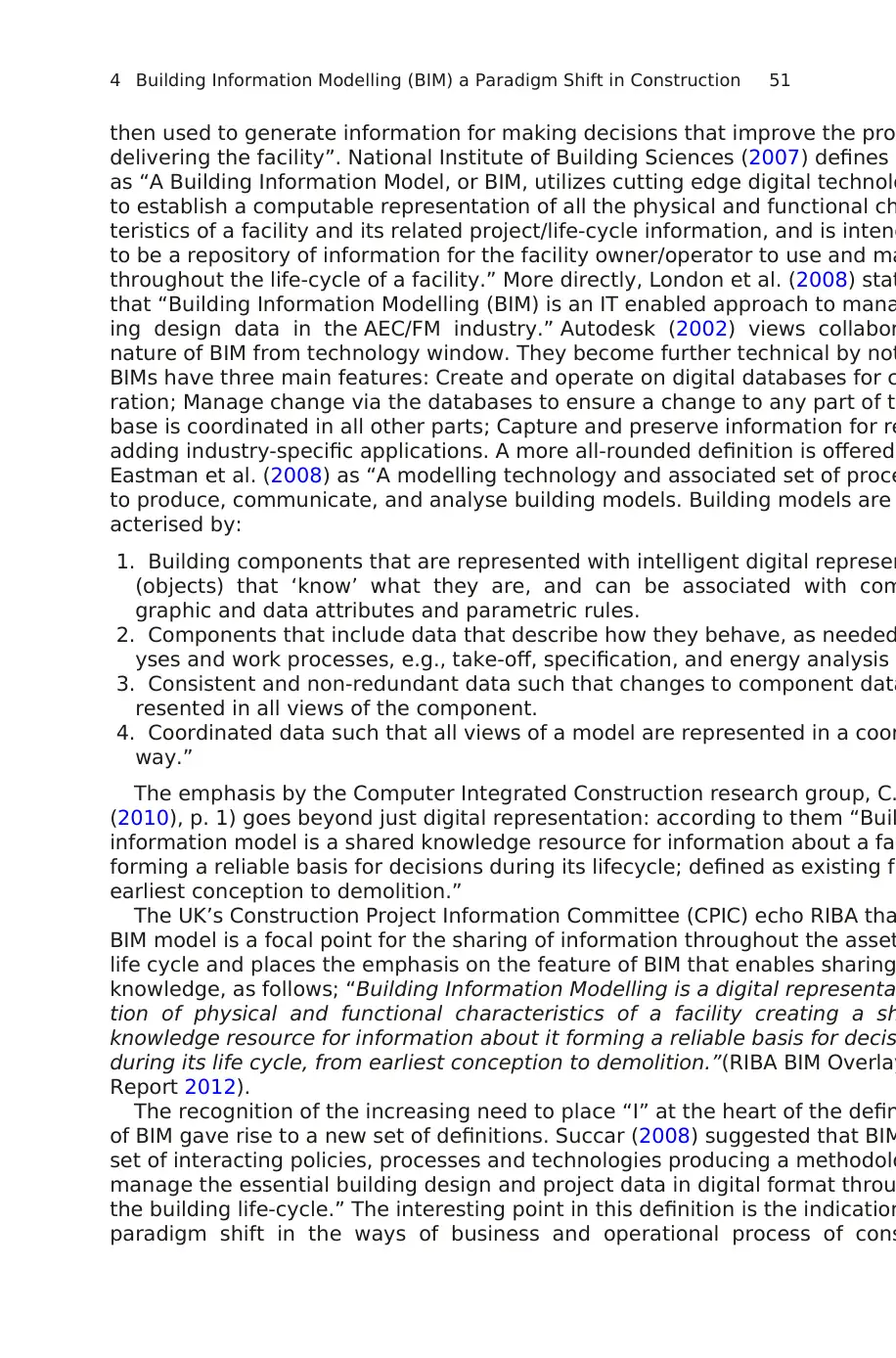
51
then used to generate information for making decisions that improve the pro
delivering the facility”. National Institute of Building Sciences (2007) defines B
as “A Building Information Model, or BIM, utilizes cutting edge digital technolo
to establish a computable representation of all the physical and functional ch
teristics of a facility and its related project/life-cycle information, and is intend
to be a repository of information for the facility owner/operator to use and ma
throughout the life-cycle of a facility.” More directly, London et al. (2008) stat
that “Building Information Modelling (BIM) is an IT enabled approach to mana
ing design data in the AEC/FM industry.” Autodesk (2002) views collabor
nature of BIM from technology window. They become further technical by not
BIMs have three main features: Create and operate on digital databases for c
ration; Manage change via the databases to ensure a change to any part of th
base is coordinated in all other parts; Capture and preserve information for re
adding industry-specific applications. A more all-rounded definition is offered
Eastman et al. (2008) as “A modelling technology and associated set of proce
to produce, communicate, and analyse building models. Building models are
acterised by:
1. Building components that are represented with intelligent digital represen
(objects) that ‘know’ what they are, and can be associated with com
graphic and data attributes and parametric rules.
2. Components that include data that describe how they behave, as needed
yses and work processes, e.g., take-off, specification, and energy analysis
3. Consistent and non-redundant data such that changes to component data
resented in all views of the component.
4. Coordinated data such that all views of a model are represented in a coor
way.”
The emphasis by the Computer Integrated Construction research group, C.
(2010), p. 1) goes beyond just digital representation: according to them “Buil
information model is a shared knowledge resource for information about a fac
forming a reliable basis for decisions during its lifecycle; defined as existing fr
earliest conception to demolition.”
The UK’s Construction Project Information Committee (CPIC) echo RIBA tha
BIM model is a focal point for the sharing of information throughout the asset
life cycle and places the emphasis on the feature of BIM that enables sharing
knowledge, as follows; “Building Information Modelling is a digital representa
tion of physical and functional characteristics of a facility creating a sh
knowledge resource for information about it forming a reliable basis for decis
during its life cycle, from earliest conception to demolition.”(RIBA BIM Overlay
Report 2012).
The recognition of the increasing need to place “I” at the heart of the defin
of BIM gave rise to a new set of definitions. Succar (2008) suggested that BIM
set of interacting policies, processes and technologies producing a methodolo
manage the essential building design and project data in digital format throu
the building life-cycle.” The interesting point in this definition is the indication
paradigm shift in the ways of business and operational process of cons
4 Building Information Modelling (BIM) a Paradigm Shift in Construction
then used to generate information for making decisions that improve the pro
delivering the facility”. National Institute of Building Sciences (2007) defines B
as “A Building Information Model, or BIM, utilizes cutting edge digital technolo
to establish a computable representation of all the physical and functional ch
teristics of a facility and its related project/life-cycle information, and is intend
to be a repository of information for the facility owner/operator to use and ma
throughout the life-cycle of a facility.” More directly, London et al. (2008) stat
that “Building Information Modelling (BIM) is an IT enabled approach to mana
ing design data in the AEC/FM industry.” Autodesk (2002) views collabor
nature of BIM from technology window. They become further technical by not
BIMs have three main features: Create and operate on digital databases for c
ration; Manage change via the databases to ensure a change to any part of th
base is coordinated in all other parts; Capture and preserve information for re
adding industry-specific applications. A more all-rounded definition is offered
Eastman et al. (2008) as “A modelling technology and associated set of proce
to produce, communicate, and analyse building models. Building models are
acterised by:
1. Building components that are represented with intelligent digital represen
(objects) that ‘know’ what they are, and can be associated with com
graphic and data attributes and parametric rules.
2. Components that include data that describe how they behave, as needed
yses and work processes, e.g., take-off, specification, and energy analysis
3. Consistent and non-redundant data such that changes to component data
resented in all views of the component.
4. Coordinated data such that all views of a model are represented in a coor
way.”
The emphasis by the Computer Integrated Construction research group, C.
(2010), p. 1) goes beyond just digital representation: according to them “Buil
information model is a shared knowledge resource for information about a fac
forming a reliable basis for decisions during its lifecycle; defined as existing fr
earliest conception to demolition.”
The UK’s Construction Project Information Committee (CPIC) echo RIBA tha
BIM model is a focal point for the sharing of information throughout the asset
life cycle and places the emphasis on the feature of BIM that enables sharing
knowledge, as follows; “Building Information Modelling is a digital representa
tion of physical and functional characteristics of a facility creating a sh
knowledge resource for information about it forming a reliable basis for decis
during its life cycle, from earliest conception to demolition.”(RIBA BIM Overlay
Report 2012).
The recognition of the increasing need to place “I” at the heart of the defin
of BIM gave rise to a new set of definitions. Succar (2008) suggested that BIM
set of interacting policies, processes and technologies producing a methodolo
manage the essential building design and project data in digital format throu
the building life-cycle.” The interesting point in this definition is the indication
paradigm shift in the ways of business and operational process of cons
4 Building Information Modelling (BIM) a Paradigm Shift in Construction
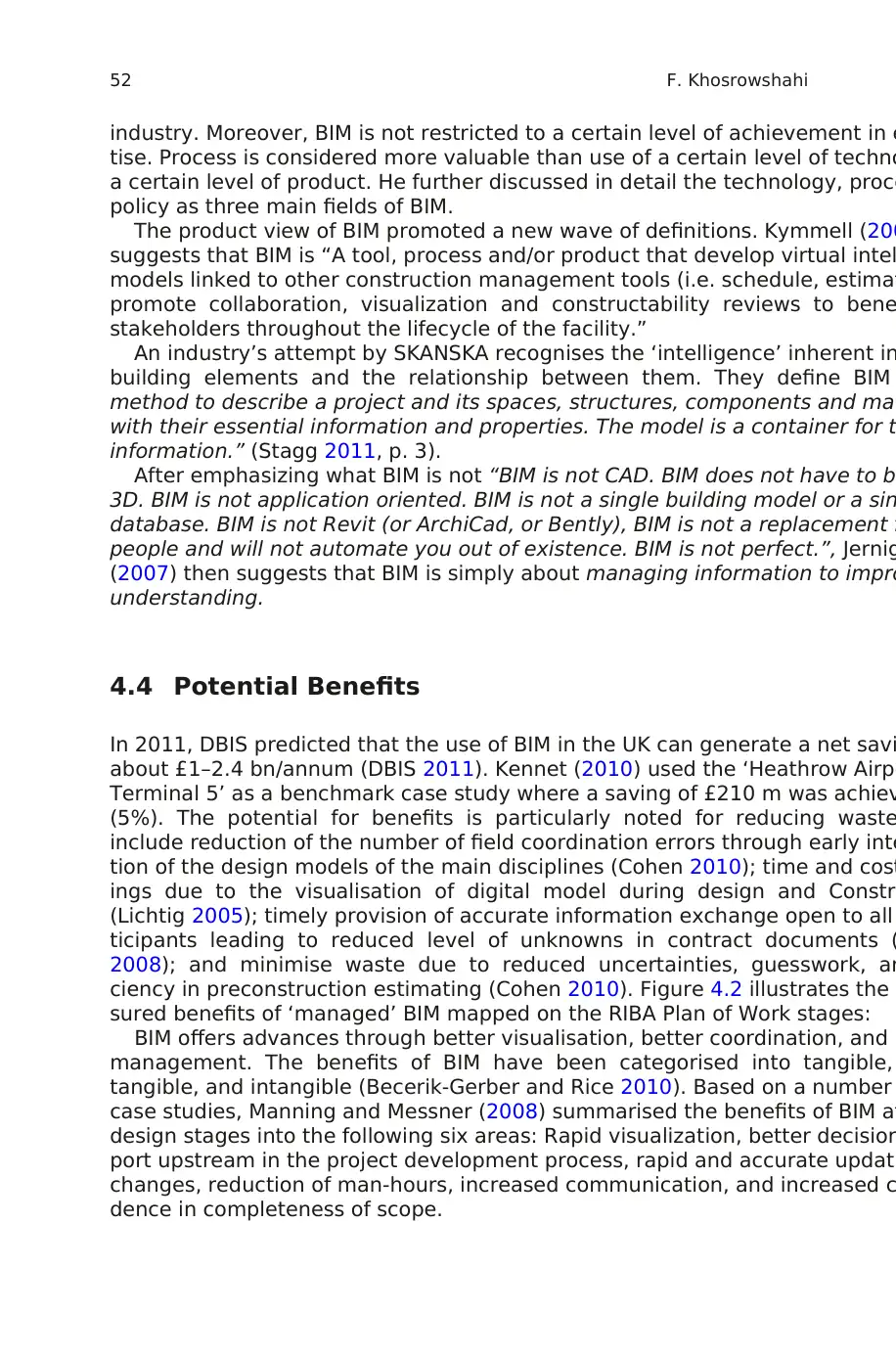
52
industry. Moreover, BIM is not restricted to a certain level of achievement in e
tise. Process is considered more valuable than use of a certain level of techno
a certain level of product. He further discussed in detail the technology, proce
policy as three main fields of BIM.
The product view of BIM promoted a new wave of definitions. Kymmell (200
suggests that BIM is “A tool, process and/or product that develop virtual intel
models linked to other construction management tools (i.e. schedule, estimat
promote collaboration, visualization and constructability reviews to bene
stakeholders throughout the lifecycle of the facility.”
An industry’s attempt by SKANSKA recognises the ‘intelligence’ inherent in
building elements and the relationship between them. They define BIM
method to describe a project and its spaces, structures, components and mat
with their essential information and properties. The model is a container for t
information.” (Stagg 2011, p. 3).
After emphasizing what BIM is not “BIM is not CAD. BIM does not have to b
3D. BIM is not application oriented. BIM is not a single building model or a sin
database. BIM is not Revit (or ArchiCad, or Bently), BIM is not a replacement f
people and will not automate you out of existence. BIM is not perfect.”, Jernig
(2007) then suggests that BIM is simply about managing information to impro
understanding.
4.4 Potential Benefits
In 2011, DBIS predicted that the use of BIM in the UK can generate a net savi
about £1–2.4 bn/annum (DBIS 2011). Kennet (2010) used the ‘Heathrow Airpo
Terminal 5’ as a benchmark case study where a saving of £210 m was achiev
(5%). The potential for benefits is particularly noted for reducing waste
include reduction of the number of field coordination errors through early inte
tion of the design models of the main disciplines (Cohen 2010); time and cost
ings due to the visualisation of digital model during design and Constr
(Lichtig 2005); timely provision of accurate information exchange open to all
ticipants leading to reduced level of unknowns in contract documents (
2008); and minimise waste due to reduced uncertainties, guesswork, an
ciency in preconstruction estimating (Cohen 2010). Figure 4.2 illustrates the
sured benefits of ‘managed’ BIM mapped on the RIBA Plan of Work stages:
BIM offers advances through better visualisation, better coordination, and b
management. The benefits of BIM have been categorised into tangible,
tangible, and intangible (Becerik-Gerber and Rice 2010). Based on a number
case studies, Manning and Messner (2008) summarised the benefits of BIM at
design stages into the following six areas: Rapid visualization, better decision
port upstream in the project development process, rapid and accurate updati
changes, reduction of man-hours, increased communication, and increased c
dence in completeness of scope.
F. Khosrowshahi
industry. Moreover, BIM is not restricted to a certain level of achievement in e
tise. Process is considered more valuable than use of a certain level of techno
a certain level of product. He further discussed in detail the technology, proce
policy as three main fields of BIM.
The product view of BIM promoted a new wave of definitions. Kymmell (200
suggests that BIM is “A tool, process and/or product that develop virtual intel
models linked to other construction management tools (i.e. schedule, estimat
promote collaboration, visualization and constructability reviews to bene
stakeholders throughout the lifecycle of the facility.”
An industry’s attempt by SKANSKA recognises the ‘intelligence’ inherent in
building elements and the relationship between them. They define BIM
method to describe a project and its spaces, structures, components and mat
with their essential information and properties. The model is a container for t
information.” (Stagg 2011, p. 3).
After emphasizing what BIM is not “BIM is not CAD. BIM does not have to b
3D. BIM is not application oriented. BIM is not a single building model or a sin
database. BIM is not Revit (or ArchiCad, or Bently), BIM is not a replacement f
people and will not automate you out of existence. BIM is not perfect.”, Jernig
(2007) then suggests that BIM is simply about managing information to impro
understanding.
4.4 Potential Benefits
In 2011, DBIS predicted that the use of BIM in the UK can generate a net savi
about £1–2.4 bn/annum (DBIS 2011). Kennet (2010) used the ‘Heathrow Airpo
Terminal 5’ as a benchmark case study where a saving of £210 m was achiev
(5%). The potential for benefits is particularly noted for reducing waste
include reduction of the number of field coordination errors through early inte
tion of the design models of the main disciplines (Cohen 2010); time and cost
ings due to the visualisation of digital model during design and Constr
(Lichtig 2005); timely provision of accurate information exchange open to all
ticipants leading to reduced level of unknowns in contract documents (
2008); and minimise waste due to reduced uncertainties, guesswork, an
ciency in preconstruction estimating (Cohen 2010). Figure 4.2 illustrates the
sured benefits of ‘managed’ BIM mapped on the RIBA Plan of Work stages:
BIM offers advances through better visualisation, better coordination, and b
management. The benefits of BIM have been categorised into tangible,
tangible, and intangible (Becerik-Gerber and Rice 2010). Based on a number
case studies, Manning and Messner (2008) summarised the benefits of BIM at
design stages into the following six areas: Rapid visualization, better decision
port upstream in the project development process, rapid and accurate updati
changes, reduction of man-hours, increased communication, and increased c
dence in completeness of scope.
F. Khosrowshahi
⊘ This is a preview!⊘
Do you want full access?
Subscribe today to unlock all pages.

Trusted by 1+ million students worldwide
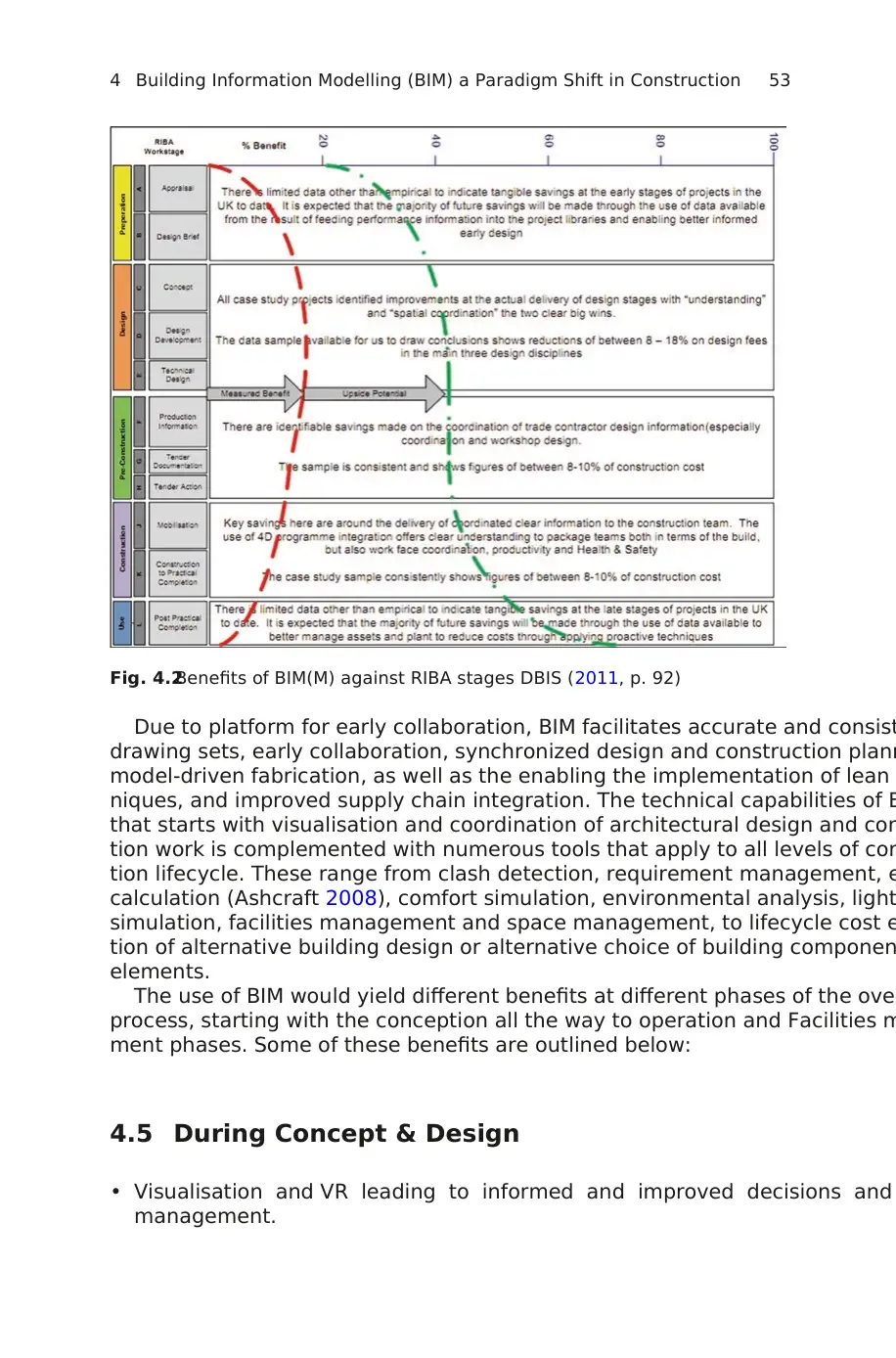
53
Due to platform for early collaboration, BIM facilitates accurate and consist
drawing sets, early collaboration, synchronized design and construction plann
model-driven fabrication, as well as the enabling the implementation of lean
niques, and improved supply chain integration. The technical capabilities of B
that starts with visualisation and coordination of architectural design and con
tion work is complemented with numerous tools that apply to all levels of con
tion lifecycle. These range from clash detection, requirement management, e
calculation (Ashcraft 2008), comfort simulation, environmental analysis, light
simulation, facilities management and space management, to lifecycle cost e
tion of alternative building design or alternative choice of building componen
elements.
The use of BIM would yield different benefits at different phases of the over
process, starting with the conception all the way to operation and Facilities m
ment phases. Some of these benefits are outlined below:
4.5 During Concept & Design
• Visualisation and VR leading to informed and improved decisions and
management.
Fig. 4.2Benefits of BIM(M) against RIBA stages DBIS (2011, p. 92)
4 Building Information Modelling (BIM) a Paradigm Shift in Construction
Due to platform for early collaboration, BIM facilitates accurate and consist
drawing sets, early collaboration, synchronized design and construction plann
model-driven fabrication, as well as the enabling the implementation of lean
niques, and improved supply chain integration. The technical capabilities of B
that starts with visualisation and coordination of architectural design and con
tion work is complemented with numerous tools that apply to all levels of con
tion lifecycle. These range from clash detection, requirement management, e
calculation (Ashcraft 2008), comfort simulation, environmental analysis, light
simulation, facilities management and space management, to lifecycle cost e
tion of alternative building design or alternative choice of building componen
elements.
The use of BIM would yield different benefits at different phases of the over
process, starting with the conception all the way to operation and Facilities m
ment phases. Some of these benefits are outlined below:
4.5 During Concept & Design
• Visualisation and VR leading to informed and improved decisions and
management.
Fig. 4.2Benefits of BIM(M) against RIBA stages DBIS (2011, p. 92)
4 Building Information Modelling (BIM) a Paradigm Shift in Construction
Paraphrase This Document
Need a fresh take? Get an instant paraphrase of this document with our AI Paraphraser
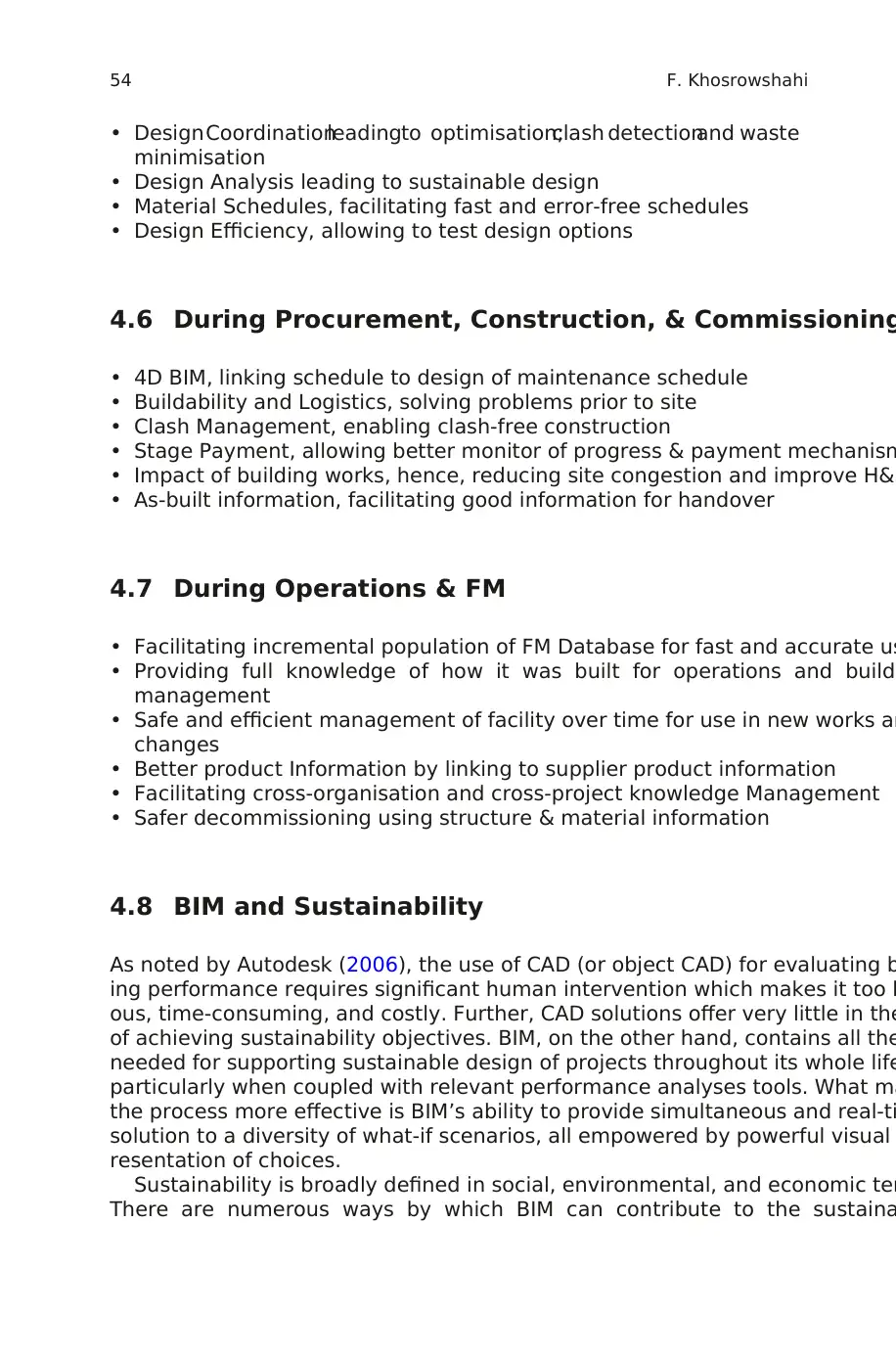
54
• Design Coordinationleadingto optimisation;clash detectionand waste
minimisation
• Design Analysis leading to sustainable design
• Material Schedules, facilitating fast and error-free schedules
• Design Efficiency, allowing to test design options
4.6 During Procurement, Construction, & Commissioning
• 4D BIM, linking schedule to design of maintenance schedule
• Buildability and Logistics, solving problems prior to site
• Clash Management, enabling clash-free construction
• Stage Payment, allowing better monitor of progress & payment mechanism
• Impact of building works, hence, reducing site congestion and improve H&S
• As-built information, facilitating good information for handover
4.7 During Operations & FM
• Facilitating incremental population of FM Database for fast and accurate us
• Providing full knowledge of how it was built for operations and build
management
• Safe and efficient management of facility over time for use in new works an
changes
• Better product Information by linking to supplier product information
• Facilitating cross-organisation and cross-project knowledge Management
• Safer decommissioning using structure & material information
4.8 BIM and Sustainability
As noted by Autodesk (2006), the use of CAD (or object CAD) for evaluating b
ing performance requires significant human intervention which makes it too l
ous, time-consuming, and costly. Further, CAD solutions offer very little in the
of achieving sustainability objectives. BIM, on the other hand, contains all the
needed for supporting sustainable design of projects throughout its whole life
particularly when coupled with relevant performance analyses tools. What ma
the process more effective is BIM’s ability to provide simultaneous and real-ti
solution to a diversity of what-if scenarios, all empowered by powerful visual
resentation of choices.
Sustainability is broadly defined in social, environmental, and economic ter
There are numerous ways by which BIM can contribute to the sustaina
F. Khosrowshahi
• Design Coordinationleadingto optimisation;clash detectionand waste
minimisation
• Design Analysis leading to sustainable design
• Material Schedules, facilitating fast and error-free schedules
• Design Efficiency, allowing to test design options
4.6 During Procurement, Construction, & Commissioning
• 4D BIM, linking schedule to design of maintenance schedule
• Buildability and Logistics, solving problems prior to site
• Clash Management, enabling clash-free construction
• Stage Payment, allowing better monitor of progress & payment mechanism
• Impact of building works, hence, reducing site congestion and improve H&S
• As-built information, facilitating good information for handover
4.7 During Operations & FM
• Facilitating incremental population of FM Database for fast and accurate us
• Providing full knowledge of how it was built for operations and build
management
• Safe and efficient management of facility over time for use in new works an
changes
• Better product Information by linking to supplier product information
• Facilitating cross-organisation and cross-project knowledge Management
• Safer decommissioning using structure & material information
4.8 BIM and Sustainability
As noted by Autodesk (2006), the use of CAD (or object CAD) for evaluating b
ing performance requires significant human intervention which makes it too l
ous, time-consuming, and costly. Further, CAD solutions offer very little in the
of achieving sustainability objectives. BIM, on the other hand, contains all the
needed for supporting sustainable design of projects throughout its whole life
particularly when coupled with relevant performance analyses tools. What ma
the process more effective is BIM’s ability to provide simultaneous and real-ti
solution to a diversity of what-if scenarios, all empowered by powerful visual
resentation of choices.
Sustainability is broadly defined in social, environmental, and economic ter
There are numerous ways by which BIM can contribute to the sustaina
F. Khosrowshahi
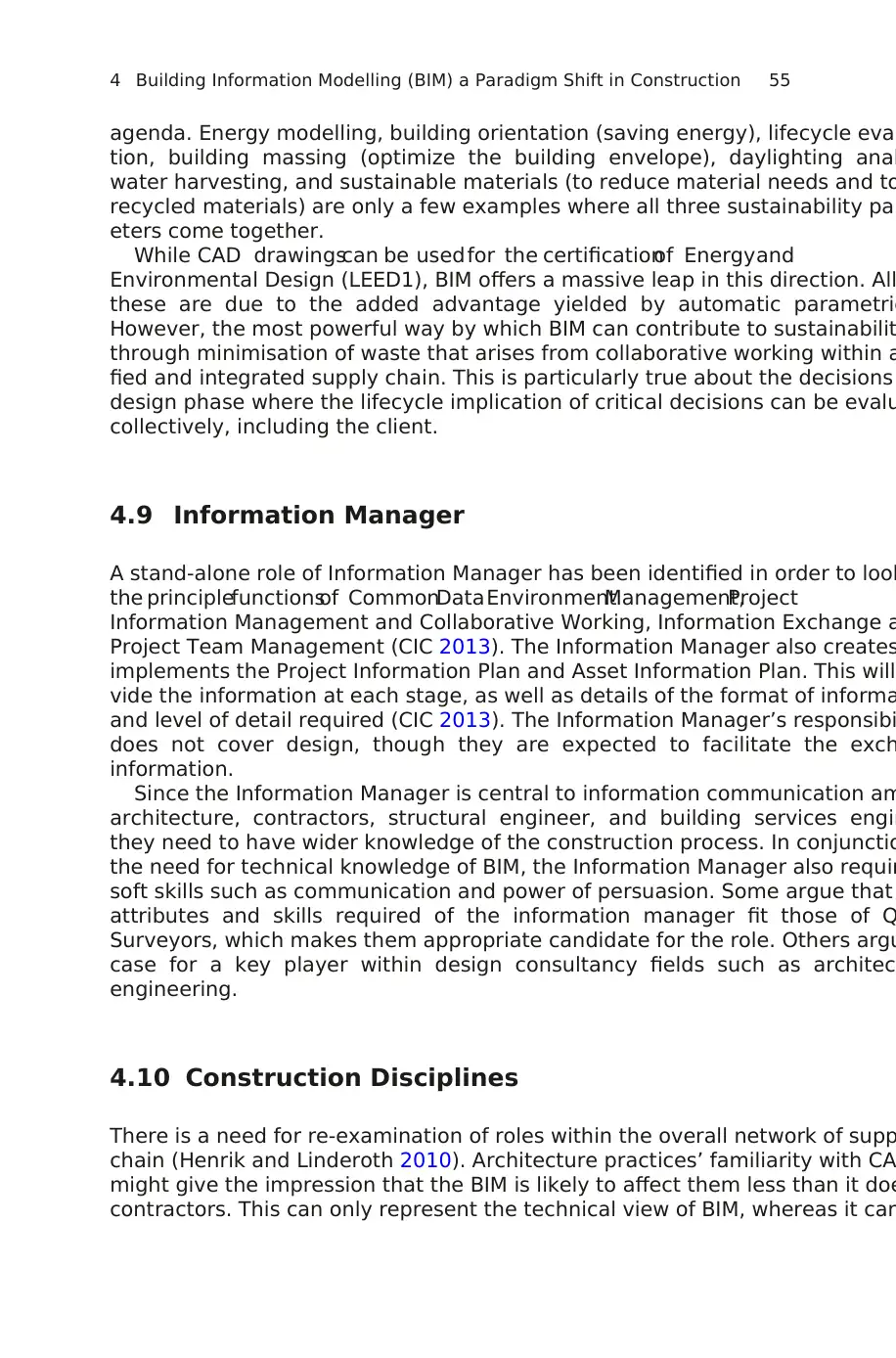
55
agenda. Energy modelling, building orientation (saving energy), lifecycle eval
tion, building massing (optimize the building envelope), daylighting anal
water harvesting, and sustainable materials (to reduce material needs and to
recycled materials) are only a few examples where all three sustainability par
eters come together.
While CAD drawingscan be used for the certificationof Energy and
Environmental Design (LEED1), BIM offers a massive leap in this direction. All
these are due to the added advantage yielded by automatic parametric
However, the most powerful way by which BIM can contribute to sustainabilit
through minimisation of waste that arises from collaborative working within a
fied and integrated supply chain. This is particularly true about the decisions
design phase where the lifecycle implication of critical decisions can be evalu
collectively, including the client.
4.9 Information Manager
A stand-alone role of Information Manager has been identified in order to look
the principlefunctionsof CommonData EnvironmentManagement,Project
Information Management and Collaborative Working, Information Exchange a
Project Team Management (CIC 2013). The Information Manager also creates
implements the Project Information Plan and Asset Information Plan. This will
vide the information at each stage, as well as details of the format of informa
and level of detail required (CIC 2013). The Information Manager’s responsibi
does not cover design, though they are expected to facilitate the exch
information.
Since the Information Manager is central to information communication am
architecture, contractors, structural engineer, and building services engin
they need to have wider knowledge of the construction process. In conjunctio
the need for technical knowledge of BIM, the Information Manager also requir
soft skills such as communication and power of persuasion. Some argue that
attributes and skills required of the information manager fit those of Q
Surveyors, which makes them appropriate candidate for the role. Others argu
case for a key player within design consultancy fields such as architec
engineering.
4.10 Construction Disciplines
There is a need for re-examination of roles within the overall network of supp
chain (Henrik and Linderoth 2010). Architecture practices’ familiarity with CA
might give the impression that the BIM is likely to affect them less than it doe
contractors. This can only represent the technical view of BIM, whereas it can
4 Building Information Modelling (BIM) a Paradigm Shift in Construction
agenda. Energy modelling, building orientation (saving energy), lifecycle eval
tion, building massing (optimize the building envelope), daylighting anal
water harvesting, and sustainable materials (to reduce material needs and to
recycled materials) are only a few examples where all three sustainability par
eters come together.
While CAD drawingscan be used for the certificationof Energy and
Environmental Design (LEED1), BIM offers a massive leap in this direction. All
these are due to the added advantage yielded by automatic parametric
However, the most powerful way by which BIM can contribute to sustainabilit
through minimisation of waste that arises from collaborative working within a
fied and integrated supply chain. This is particularly true about the decisions
design phase where the lifecycle implication of critical decisions can be evalu
collectively, including the client.
4.9 Information Manager
A stand-alone role of Information Manager has been identified in order to look
the principlefunctionsof CommonData EnvironmentManagement,Project
Information Management and Collaborative Working, Information Exchange a
Project Team Management (CIC 2013). The Information Manager also creates
implements the Project Information Plan and Asset Information Plan. This will
vide the information at each stage, as well as details of the format of informa
and level of detail required (CIC 2013). The Information Manager’s responsibi
does not cover design, though they are expected to facilitate the exch
information.
Since the Information Manager is central to information communication am
architecture, contractors, structural engineer, and building services engin
they need to have wider knowledge of the construction process. In conjunctio
the need for technical knowledge of BIM, the Information Manager also requir
soft skills such as communication and power of persuasion. Some argue that
attributes and skills required of the information manager fit those of Q
Surveyors, which makes them appropriate candidate for the role. Others argu
case for a key player within design consultancy fields such as architec
engineering.
4.10 Construction Disciplines
There is a need for re-examination of roles within the overall network of supp
chain (Henrik and Linderoth 2010). Architecture practices’ familiarity with CA
might give the impression that the BIM is likely to affect them less than it doe
contractors. This can only represent the technical view of BIM, whereas it can
4 Building Information Modelling (BIM) a Paradigm Shift in Construction
⊘ This is a preview!⊘
Do you want full access?
Subscribe today to unlock all pages.

Trusted by 1+ million students worldwide
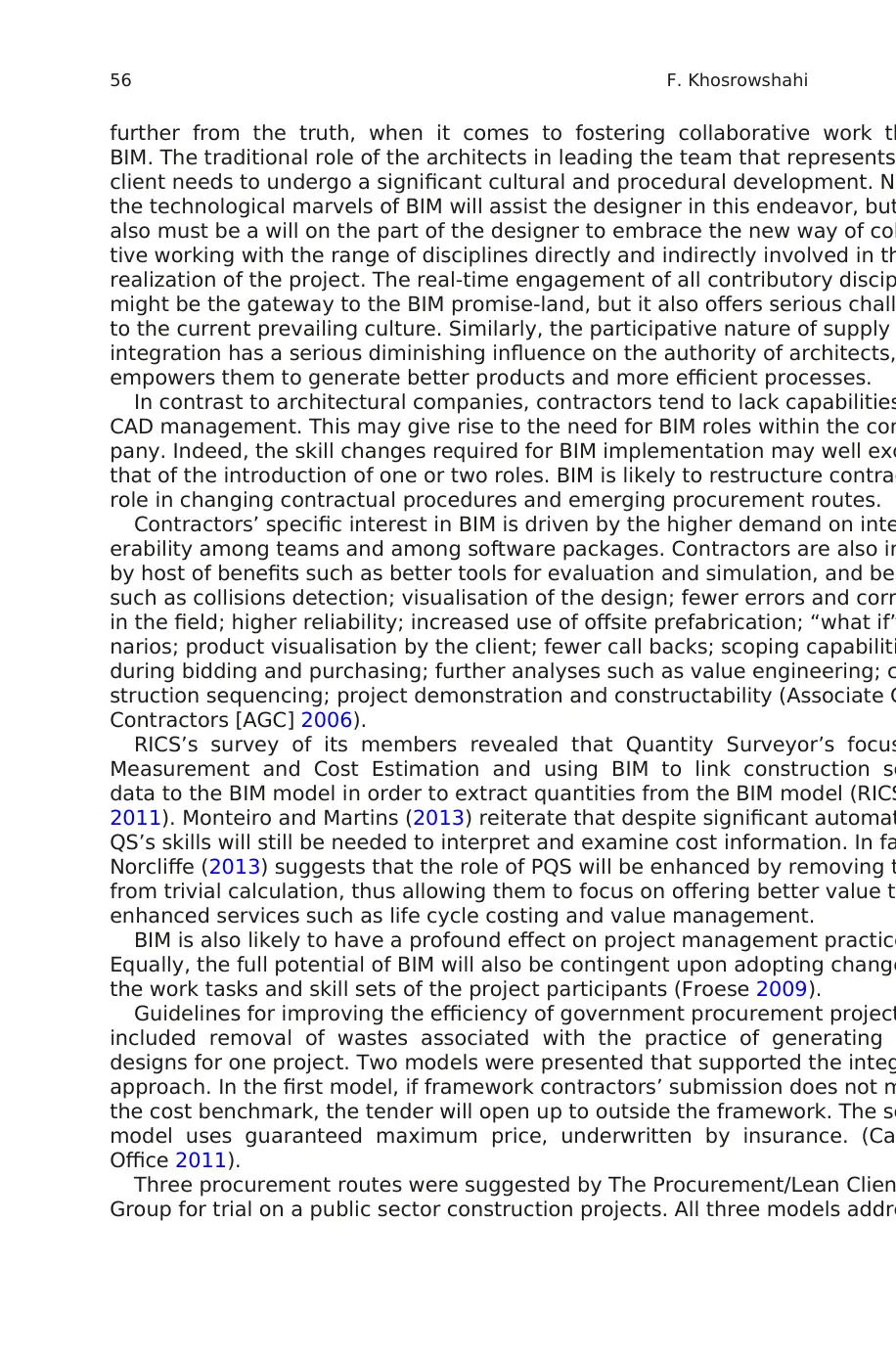
56
further from the truth, when it comes to fostering collaborative work th
BIM. The traditional role of the architects in leading the team that represents
client needs to undergo a significant cultural and procedural development. Na
the technological marvels of BIM will assist the designer in this endeavor, but
also must be a will on the part of the designer to embrace the new way of col
tive working with the range of disciplines directly and indirectly involved in th
realization of the project. The real-time engagement of all contributory discip
might be the gateway to the BIM promise-land, but it also offers serious chall
to the current prevailing culture. Similarly, the participative nature of supply
integration has a serious diminishing influence on the authority of architects,
empowers them to generate better products and more efficient processes.
In contrast to architectural companies, contractors tend to lack capabilities
CAD management. This may give rise to the need for BIM roles within the com
pany. Indeed, the skill changes required for BIM implementation may well exc
that of the introduction of one or two roles. BIM is likely to restructure contrac
role in changing contractual procedures and emerging procurement routes.
Contractors’ specific interest in BIM is driven by the higher demand on inte
erability among teams and among software packages. Contractors are also in
by host of benefits such as better tools for evaluation and simulation, and ben
such as collisions detection; visualisation of the design; fewer errors and corr
in the field; higher reliability; increased use of offsite prefabrication; “what if”
narios; product visualisation by the client; fewer call backs; scoping capabiliti
during bidding and purchasing; further analyses such as value engineering; c
struction sequencing; project demonstration and constructability (Associate G
Contractors [AGC] 2006).
RICS’s survey of its members revealed that Quantity Surveyor’s focus
Measurement and Cost Estimation and using BIM to link construction sc
data to the BIM model in order to extract quantities from the BIM model (RICS
2011). Monteiro and Martins (2013) reiterate that despite significant automat
QS’s skills will still be needed to interpret and examine cost information. In fa
Norcliffe (2013) suggests that the role of PQS will be enhanced by removing t
from trivial calculation, thus allowing them to focus on offering better value t
enhanced services such as life cycle costing and value management.
BIM is also likely to have a profound effect on project management practice
Equally, the full potential of BIM will also be contingent upon adopting change
the work tasks and skill sets of the project participants (Froese 2009).
Guidelines for improving the efficiency of government procurement project
included removal of wastes associated with the practice of generating
designs for one project. Two models were presented that supported the integ
approach. In the first model, if framework contractors’ submission does not m
the cost benchmark, the tender will open up to outside the framework. The se
model uses guaranteed maximum price, underwritten by insurance. (Ca
Office 2011).
Three procurement routes were suggested by The Procurement/Lean Clien
Group for trial on a public sector construction projects. All three models addre
F. Khosrowshahi
further from the truth, when it comes to fostering collaborative work th
BIM. The traditional role of the architects in leading the team that represents
client needs to undergo a significant cultural and procedural development. Na
the technological marvels of BIM will assist the designer in this endeavor, but
also must be a will on the part of the designer to embrace the new way of col
tive working with the range of disciplines directly and indirectly involved in th
realization of the project. The real-time engagement of all contributory discip
might be the gateway to the BIM promise-land, but it also offers serious chall
to the current prevailing culture. Similarly, the participative nature of supply
integration has a serious diminishing influence on the authority of architects,
empowers them to generate better products and more efficient processes.
In contrast to architectural companies, contractors tend to lack capabilities
CAD management. This may give rise to the need for BIM roles within the com
pany. Indeed, the skill changes required for BIM implementation may well exc
that of the introduction of one or two roles. BIM is likely to restructure contrac
role in changing contractual procedures and emerging procurement routes.
Contractors’ specific interest in BIM is driven by the higher demand on inte
erability among teams and among software packages. Contractors are also in
by host of benefits such as better tools for evaluation and simulation, and ben
such as collisions detection; visualisation of the design; fewer errors and corr
in the field; higher reliability; increased use of offsite prefabrication; “what if”
narios; product visualisation by the client; fewer call backs; scoping capabiliti
during bidding and purchasing; further analyses such as value engineering; c
struction sequencing; project demonstration and constructability (Associate G
Contractors [AGC] 2006).
RICS’s survey of its members revealed that Quantity Surveyor’s focus
Measurement and Cost Estimation and using BIM to link construction sc
data to the BIM model in order to extract quantities from the BIM model (RICS
2011). Monteiro and Martins (2013) reiterate that despite significant automat
QS’s skills will still be needed to interpret and examine cost information. In fa
Norcliffe (2013) suggests that the role of PQS will be enhanced by removing t
from trivial calculation, thus allowing them to focus on offering better value t
enhanced services such as life cycle costing and value management.
BIM is also likely to have a profound effect on project management practice
Equally, the full potential of BIM will also be contingent upon adopting change
the work tasks and skill sets of the project participants (Froese 2009).
Guidelines for improving the efficiency of government procurement project
included removal of wastes associated with the practice of generating
designs for one project. Two models were presented that supported the integ
approach. In the first model, if framework contractors’ submission does not m
the cost benchmark, the tender will open up to outside the framework. The se
model uses guaranteed maximum price, underwritten by insurance. (Ca
Office 2011).
Three procurement routes were suggested by The Procurement/Lean Clien
Group for trial on a public sector construction projects. All three models addre
F. Khosrowshahi
Paraphrase This Document
Need a fresh take? Get an instant paraphrase of this document with our AI Paraphraser
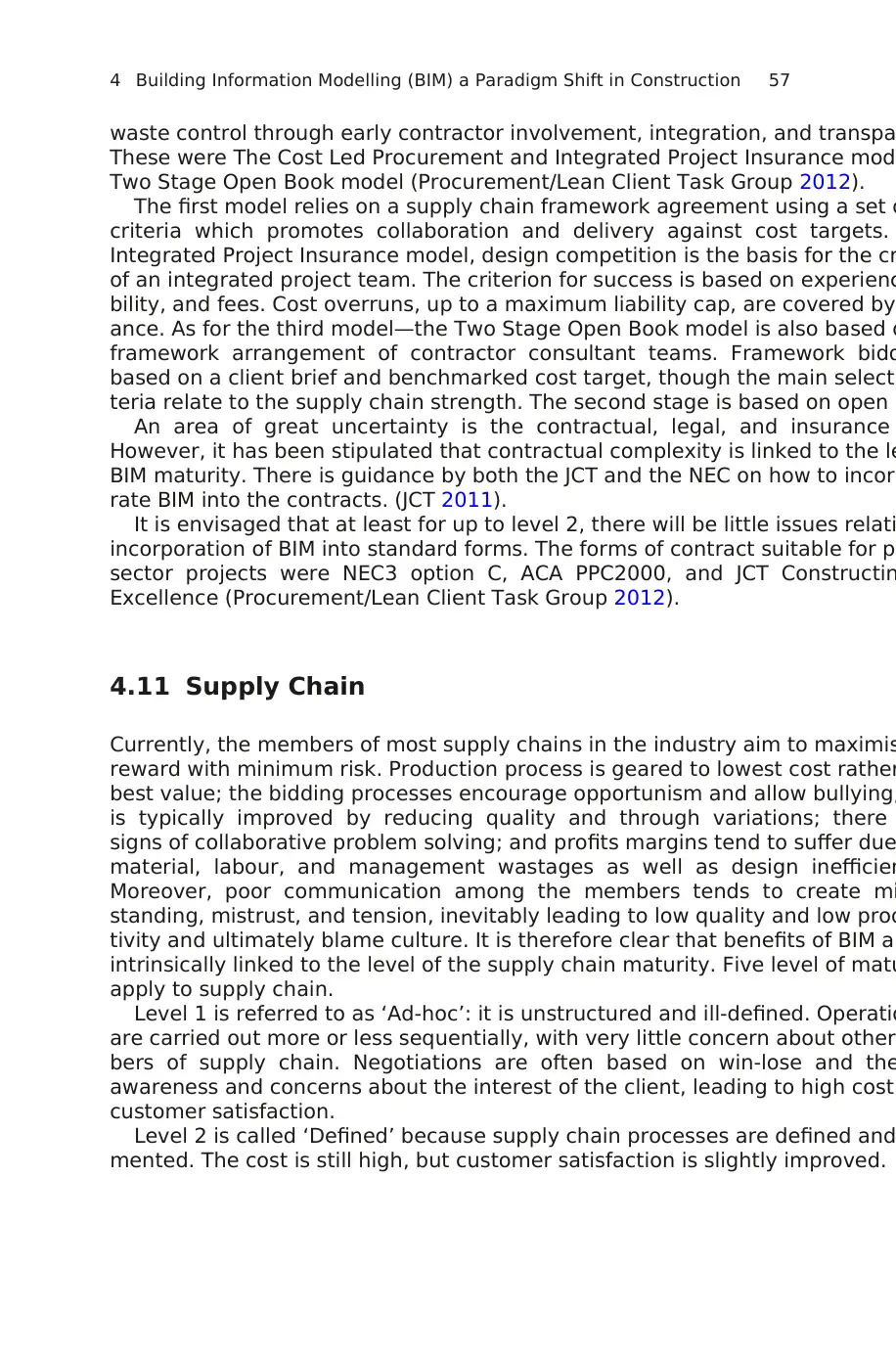
57
waste control through early contractor involvement, integration, and transpa
These were The Cost Led Procurement and Integrated Project Insurance mod
Two Stage Open Book model (Procurement/Lean Client Task Group 2012).
The first model relies on a supply chain framework agreement using a set o
criteria which promotes collaboration and delivery against cost targets.
Integrated Project Insurance model, design competition is the basis for the cr
of an integrated project team. The criterion for success is based on experienc
bility, and fees. Cost overruns, up to a maximum liability cap, are covered by
ance. As for the third model—the Two Stage Open Book model is also based o
framework arrangement of contractor consultant teams. Framework bidd
based on a client brief and benchmarked cost target, though the main selecti
teria relate to the supply chain strength. The second stage is based on open b
An area of great uncertainty is the contractual, legal, and insurance
However, it has been stipulated that contractual complexity is linked to the le
BIM maturity. There is guidance by both the JCT and the NEC on how to incorp
rate BIM into the contracts. (JCT 2011).
It is envisaged that at least for up to level 2, there will be little issues relati
incorporation of BIM into standard forms. The forms of contract suitable for p
sector projects were NEC3 option C, ACA PPC2000, and JCT Constructin
Excellence (Procurement/Lean Client Task Group 2012).
4.11 Supply Chain
Currently, the members of most supply chains in the industry aim to maximis
reward with minimum risk. Production process is geared to lowest cost rather
best value; the bidding processes encourage opportunism and allow bullying;
is typically improved by reducing quality and through variations; there
signs of collaborative problem solving; and profits margins tend to suffer due
material, labour, and management wastages as well as design inefficien
Moreover, poor communication among the members tends to create mi
standing, mistrust, and tension, inevitably leading to low quality and low prod
tivity and ultimately blame culture. It is therefore clear that benefits of BIM ar
intrinsically linked to the level of the supply chain maturity. Five level of matu
apply to supply chain.
Level 1 is referred to as ‘Ad-hoc’: it is unstructured and ill-defined. Operatio
are carried out more or less sequentially, with very little concern about other
bers of supply chain. Negotiations are often based on win-lose and the
awareness and concerns about the interest of the client, leading to high cost
customer satisfaction.
Level 2 is called ‘Defined’ because supply chain processes are defined and
mented. The cost is still high, but customer satisfaction is slightly improved.
4 Building Information Modelling (BIM) a Paradigm Shift in Construction
waste control through early contractor involvement, integration, and transpa
These were The Cost Led Procurement and Integrated Project Insurance mod
Two Stage Open Book model (Procurement/Lean Client Task Group 2012).
The first model relies on a supply chain framework agreement using a set o
criteria which promotes collaboration and delivery against cost targets.
Integrated Project Insurance model, design competition is the basis for the cr
of an integrated project team. The criterion for success is based on experienc
bility, and fees. Cost overruns, up to a maximum liability cap, are covered by
ance. As for the third model—the Two Stage Open Book model is also based o
framework arrangement of contractor consultant teams. Framework bidd
based on a client brief and benchmarked cost target, though the main selecti
teria relate to the supply chain strength. The second stage is based on open b
An area of great uncertainty is the contractual, legal, and insurance
However, it has been stipulated that contractual complexity is linked to the le
BIM maturity. There is guidance by both the JCT and the NEC on how to incorp
rate BIM into the contracts. (JCT 2011).
It is envisaged that at least for up to level 2, there will be little issues relati
incorporation of BIM into standard forms. The forms of contract suitable for p
sector projects were NEC3 option C, ACA PPC2000, and JCT Constructin
Excellence (Procurement/Lean Client Task Group 2012).
4.11 Supply Chain
Currently, the members of most supply chains in the industry aim to maximis
reward with minimum risk. Production process is geared to lowest cost rather
best value; the bidding processes encourage opportunism and allow bullying;
is typically improved by reducing quality and through variations; there
signs of collaborative problem solving; and profits margins tend to suffer due
material, labour, and management wastages as well as design inefficien
Moreover, poor communication among the members tends to create mi
standing, mistrust, and tension, inevitably leading to low quality and low prod
tivity and ultimately blame culture. It is therefore clear that benefits of BIM ar
intrinsically linked to the level of the supply chain maturity. Five level of matu
apply to supply chain.
Level 1 is referred to as ‘Ad-hoc’: it is unstructured and ill-defined. Operatio
are carried out more or less sequentially, with very little concern about other
bers of supply chain. Negotiations are often based on win-lose and the
awareness and concerns about the interest of the client, leading to high cost
customer satisfaction.
Level 2 is called ‘Defined’ because supply chain processes are defined and
mented. The cost is still high, but customer satisfaction is slightly improved.
4 Building Information Modelling (BIM) a Paradigm Shift in Construction
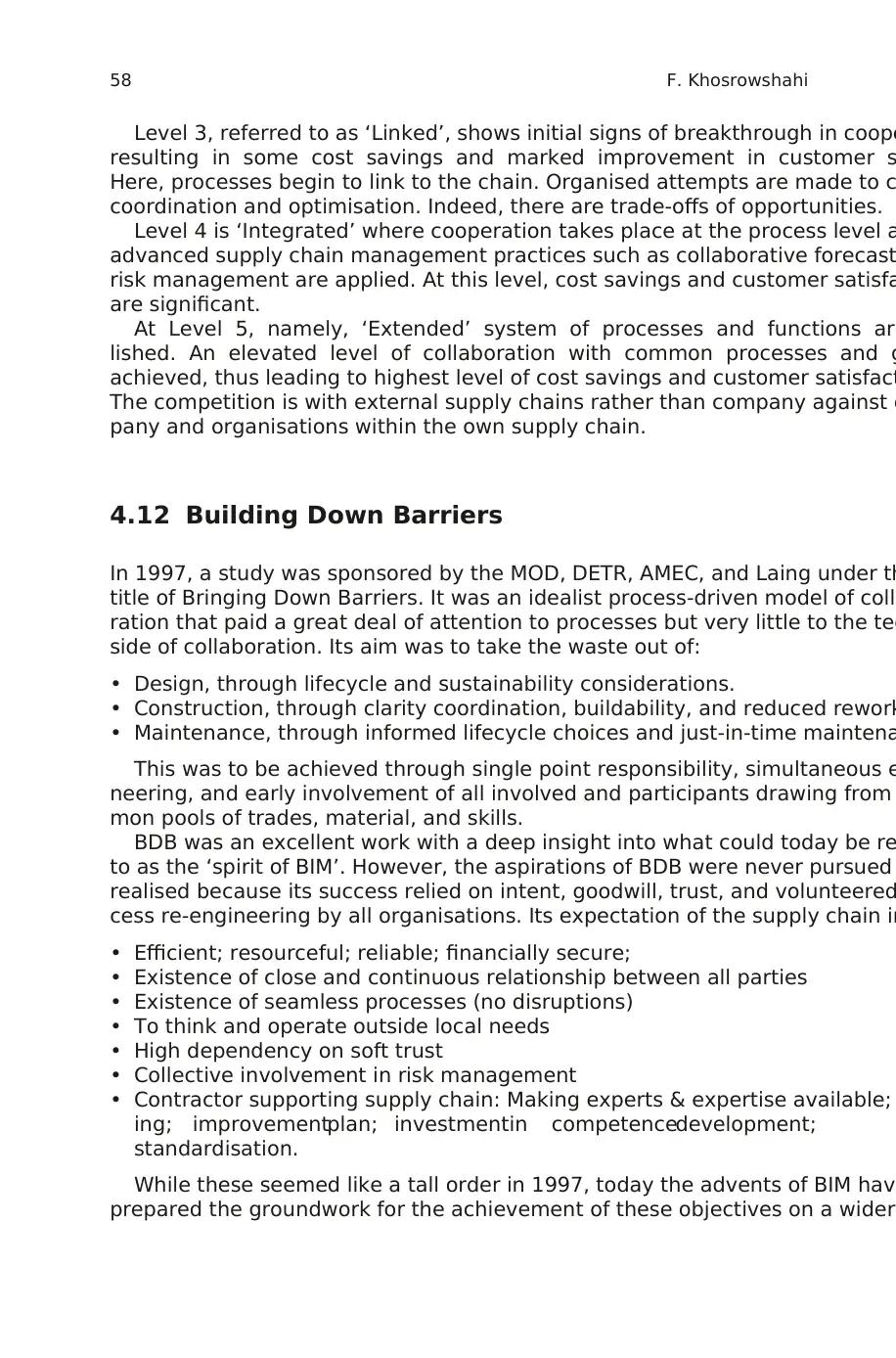
58
Level 3, referred to as ‘Linked’, shows initial signs of breakthrough in coope
resulting in some cost savings and marked improvement in customer s
Here, processes begin to link to the chain. Organised attempts are made to c
coordination and optimisation. Indeed, there are trade-offs of opportunities.
Level 4 is ‘Integrated’ where cooperation takes place at the process level a
advanced supply chain management practices such as collaborative forecast
risk management are applied. At this level, cost savings and customer satisfa
are significant.
At Level 5, namely, ‘Extended’ system of processes and functions are
lished. An elevated level of collaboration with common processes and g
achieved, thus leading to highest level of cost savings and customer satisfact
The competition is with external supply chains rather than company against c
pany and organisations within the own supply chain.
4.12 Building Down Barriers
In 1997, a study was sponsored by the MOD, DETR, AMEC, and Laing under th
title of Bringing Down Barriers. It was an idealist process-driven model of colla
ration that paid a great deal of attention to processes but very little to the tec
side of collaboration. Its aim was to take the waste out of:
• Design, through lifecycle and sustainability considerations.
• Construction, through clarity coordination, buildability, and reduced rework
• Maintenance, through informed lifecycle choices and just-in-time maintena
This was to be achieved through single point responsibility, simultaneous e
neering, and early involvement of all involved and participants drawing from
mon pools of trades, material, and skills.
BDB was an excellent work with a deep insight into what could today be re
to as the ‘spirit of BIM’. However, the aspirations of BDB were never pursued
realised because its success relied on intent, goodwill, trust, and volunteered
cess re-engineering by all organisations. Its expectation of the supply chain in
• Efficient; resourceful; reliable; financially secure;
• Existence of close and continuous relationship between all parties
• Existence of seamless processes (no disruptions)
• To think and operate outside local needs
• High dependency on soft trust
• Collective involvement in risk management
• Contractor supporting supply chain: Making experts & expertise available;
ing; improvementplan; investmentin competencedevelopment;
standardisation.
While these seemed like a tall order in 1997, today the advents of BIM have
prepared the groundwork for the achievement of these objectives on a wider
F. Khosrowshahi
Level 3, referred to as ‘Linked’, shows initial signs of breakthrough in coope
resulting in some cost savings and marked improvement in customer s
Here, processes begin to link to the chain. Organised attempts are made to c
coordination and optimisation. Indeed, there are trade-offs of opportunities.
Level 4 is ‘Integrated’ where cooperation takes place at the process level a
advanced supply chain management practices such as collaborative forecast
risk management are applied. At this level, cost savings and customer satisfa
are significant.
At Level 5, namely, ‘Extended’ system of processes and functions are
lished. An elevated level of collaboration with common processes and g
achieved, thus leading to highest level of cost savings and customer satisfact
The competition is with external supply chains rather than company against c
pany and organisations within the own supply chain.
4.12 Building Down Barriers
In 1997, a study was sponsored by the MOD, DETR, AMEC, and Laing under th
title of Bringing Down Barriers. It was an idealist process-driven model of colla
ration that paid a great deal of attention to processes but very little to the tec
side of collaboration. Its aim was to take the waste out of:
• Design, through lifecycle and sustainability considerations.
• Construction, through clarity coordination, buildability, and reduced rework
• Maintenance, through informed lifecycle choices and just-in-time maintena
This was to be achieved through single point responsibility, simultaneous e
neering, and early involvement of all involved and participants drawing from
mon pools of trades, material, and skills.
BDB was an excellent work with a deep insight into what could today be re
to as the ‘spirit of BIM’. However, the aspirations of BDB were never pursued
realised because its success relied on intent, goodwill, trust, and volunteered
cess re-engineering by all organisations. Its expectation of the supply chain in
• Efficient; resourceful; reliable; financially secure;
• Existence of close and continuous relationship between all parties
• Existence of seamless processes (no disruptions)
• To think and operate outside local needs
• High dependency on soft trust
• Collective involvement in risk management
• Contractor supporting supply chain: Making experts & expertise available;
ing; improvementplan; investmentin competencedevelopment;
standardisation.
While these seemed like a tall order in 1997, today the advents of BIM have
prepared the groundwork for the achievement of these objectives on a wider
F. Khosrowshahi
⊘ This is a preview!⊘
Do you want full access?
Subscribe today to unlock all pages.

Trusted by 1+ million students worldwide
1 out of 18
Related Documents
Your All-in-One AI-Powered Toolkit for Academic Success.
+13062052269
info@desklib.com
Available 24*7 on WhatsApp / Email
![[object Object]](/_next/static/media/star-bottom.7253800d.svg)
Unlock your academic potential
Copyright © 2020–2025 A2Z Services. All Rights Reserved. Developed and managed by ZUCOL.




